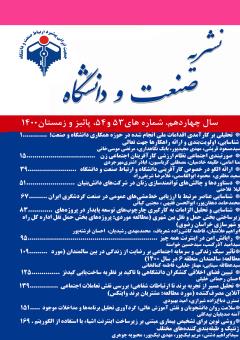شناسایی عناصر مرتبط با ارزیابی خط مشی های عمومی در صنعت گردشگری ایران
محورهای موضوعی : تخصصی
محمدحامد دهقانپور
1
![]() ,
ابوالحسن فقیهی
2
,
مجتبی کیائی
3
,
ابوالحسن فقیهی
2
,
مجتبی کیائی
3
1 - دانشجوی دکتری رشته مدیریت دولتی (تصمیمگیری و خط مشی گذاری عمومی) ، دانشکده مدیریت و اقتصاد، واحد علوم و تحقیقات، دانشگاه ازاد اسلامی، تهران، ایران
2 - استاد مدیریت دولتی، دانشکده مدیریت و اقتصاد، واحد علوم و تحقیقات، دانشگاه ازاد اسلامی، تهران، ایران
3 - استاد¬یار مدیریت دولتی، دانشکده مدیریت و اقتصاد، واحد علوم و تحقیقات، دانشگاه ازاد اسلامی، تهران، ایران
کلید واژه: خطمشیگذاری عمومی, ارزیابی خطمشی, گردشگری, روش دلفی,
چکیده مقاله :
ارزیابی خط مشی ضامن کنترل، جهت دهی و کمال بخشی به آنها است؛ اما در صنعت گردشگری کمتر به آن توجه شده است. پژوهش حاضر با هدف شناسایی عناصر اصلی مرتبط با ارزیابی خطمشی های گردشگری در ایران گامی برای پوشش نسبی این خلأ دانشی است تا پاسخگوی این سؤال اصلی پژوهش باشد: عناصر اساسی برای ارزیابی خطمشی هاي عمومی گردشگری در ایران کدامند؟ روش انجام این پژوهش ترکیبی است. دادههای تحقیق شامل اسناد، مدارک، متون مرتبط با موضوع و نتایج حاصل از مصاحبه با هفت نفر از خبرگان مرتبط و ارائه پرسشنامه به 21 نفر از خبرگان حوزه گردشگری و ارزیابی خطمشی بود که بهصورت روش نمونهگیری هدفمند انتخاب شدند. برای جمعآوری دادههای کیفی از بررسی اسناد و ادبیات مرتبط، ابزار مصاحبه و روش دلفی استفاده گردید. در مرحله اولیه پژوهش، 18مقوله و 59 مفهوم پایه مرتبط با موضوع شناسایی و استخراج شد. مقوله های شناسایی شده مرتبط با 5 بُعد فراگیر ارزیابی خطمشی گردشگری: تشخیص مسئله عمومی، تدوین خط مشی عمومی، مشروعیت بخشی به خطمشی، اجرای خط مشی، ارزیابی خطمشی عمومی قرار گرفت. جهت اعتبار سنجی عوامل استخراج شده اقدام به ارائه آنها به 21 نفر از خبرگان حوزه گردشگری طی سه راند روش دلفی گردید. در مجموع 44 مفهوم پایه مرتبط با 14 مقوله به شرح ذیل برای الگوی ارزیابی خطمشی های عمومی در گردشگری ایران شناسایی شد: پرداختن به مسئلۀ محوري، رویکرد جامعومانع داشتن، دغدغه بودن برای کارشناسان، عقلانی بودن خط مشی، پویایی خطمشی، انسجام خطمشی، قانونی بودن، پذیرش عمومی، بهرهوری، تعهد عملی مجریان، برخورداری از ابزارهای لازم، استمرار ارزیابی، برخورداری از شاخصهای مناسب ارزیابی، توجه به نتایج مثبت خط مشی عمومی.
Policy evaluation is the guarantor of their control, direction and perfection. But in the field of tourism industry, less attention has been paid to this important matter. The current research, with the aim of identifying the main elements related to the evaluation of tourism policies in Iran, is a step to partially cover this knowledge gap. To answer this main research question: What are the basic elements (dimensions, categories and concepts) to evaluate the general policies of tourism in Iran? The method of conducting this research is mixed (qualitative and quantitative). The research data included documents, texts related to the subject, the results of interviews with seven experts and the answers to the questionnaires of 21 experts who were selected by purposive sampling. Qualitative data was obtained from the review of related documents and literature, interview tool and Delphi method. In the initial stage, 18 categories and 59 basic concepts related to the evaluation model of public policies in Iranian tourism were identified and extracted and related to these 5 comprehensive dimensions of tourism policy evaluation: Diagnosing the problem, formulating the policy, legitimizing the policy, implementing the policy, evaluating the policy. For validation, the factors extracted during three rounds of the Delphi method were given to 21 experts. Based on the findings of the research, a total of 44 basic concepts related to the following 14 categories were identified for the evaluation model of tourism policies in Iran: Addressing the central issue, Having a comprehensive approach, Concern for experts, Rationality of the policy, Policy dynamics, Policy coherence, Legality, General admission, Efficiency, Executive commitment, Having the necessary tools, Continuity of assessment, Having appropriate evaluation indicators and Attention to the positive results of the policy
